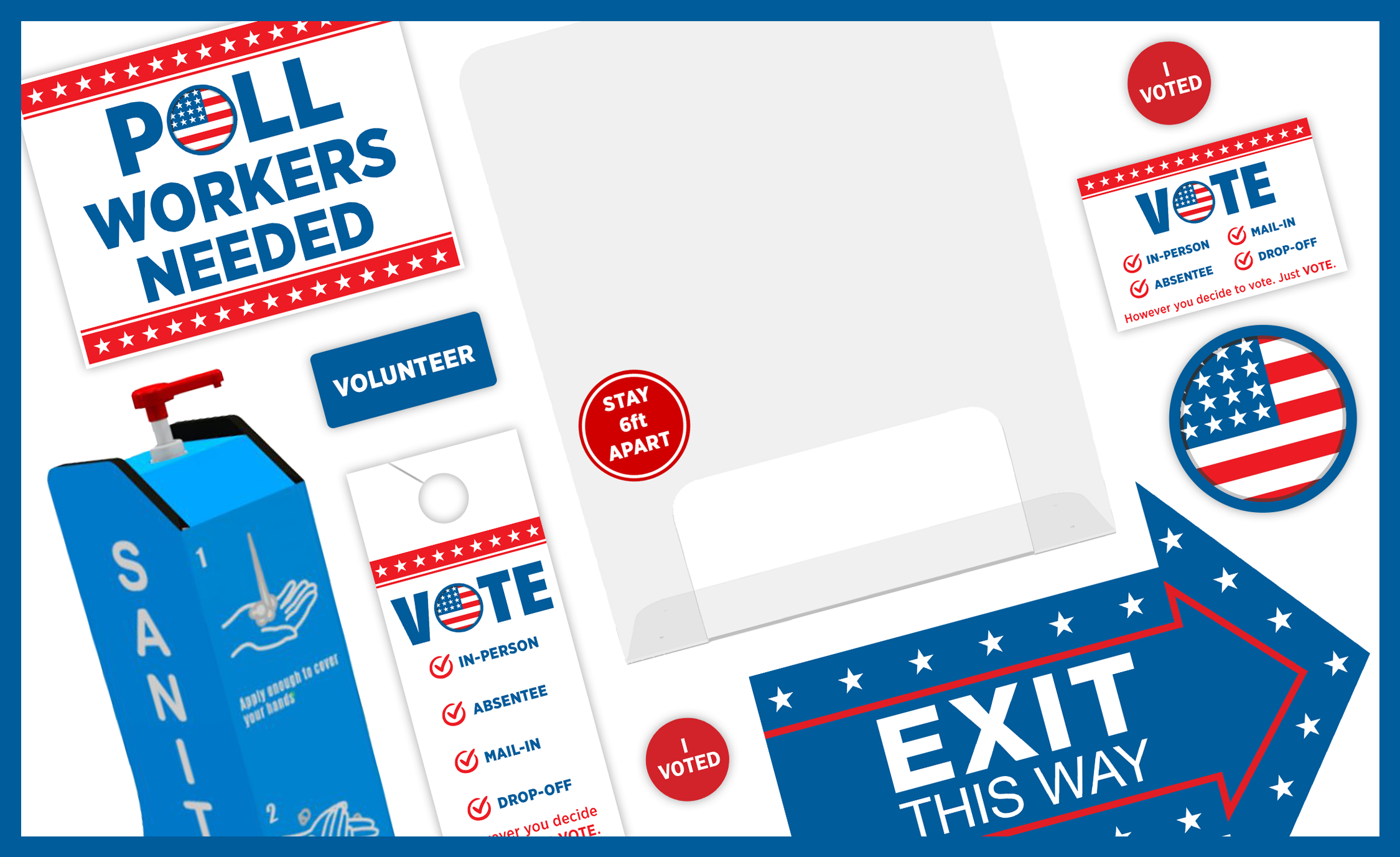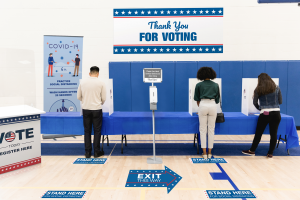 No question, voting will look different this year than in the past. Election safety needs have changed dramatically due to COVID-19. Some people are apprehensive about voting in person. Understandably, Americans are looking at all the different ways they can vote in this coming election. Voters and poll workers alike need assurances they can vote and volunteer safely. Putting voters and poll workers at ease with information and safe polling places calms fears and streamlines the voting process. This year you can expect to find more directional signage guiding the traffic flow in and out of polling places via eye-catching wall decals, floor decals, A-Frame signs, sail signs, and stencils.
No question, voting will look different this year than in the past. Election safety needs have changed dramatically due to COVID-19. Some people are apprehensive about voting in person. Understandably, Americans are looking at all the different ways they can vote in this coming election. Voters and poll workers alike need assurances they can vote and volunteer safely. Putting voters and poll workers at ease with information and safe polling places calms fears and streamlines the voting process. This year you can expect to find more directional signage guiding the traffic flow in and out of polling places via eye-catching wall decals, floor decals, A-Frame signs, sail signs, and stencils.
Communication to voters
In the weeks leading up to the election — this year more than ever — reminding voters where, when, and how they can cast their ballot is necessary. There are many questions on the minds of a large majority of voters and direct mail is a tried-and-true way to communicate with such a mass audience. Not only do politicians rely on direct mail to sway voter opinion, election, and campaign offices trust its reliability to reach voters and encourage election participation. Contactless communication tactics get the message across from a socially distant and safe spot such as door hangers, window decals, and bumper stickers. Large format banners and sail signs announcing early voting and ballot drop off locations draw the attention of voters.
Understanding all the options
Thankfully there’s more than one way to cast a ballot this fall. Each state plays by their own rules, but most include a registration process, offer early voting, absentee ballots, in-person voting, and drop-off voting. USA.gov’s navigation-friendly site is a reliable resource for answers to common and general questions about voting in the United States. To get specific on what options each state offers, FiveThirtyEight has compiled and colorfully illustrated a frequently-updated state-by-state guide to voting in the age of COVID-19. Posters with these options in local libraries, government offices, and recreational facilities will spark higher voter turnout in the community.
Absentee and mail-in voting
The system has its 15 minutes of fame this fall is absentee voting. The terms absentee voting and mail-in voting are often used interchangeably. Absentee ballots refer to ballots that are requested and then mailed when a person can’t vote in person. Mail-in ballots refer to the ballots in the context of policies that allow people to vote by mail. However, some election officials have started using the term “mail-in ballots” or “vote by mail” as states expand absentee ballot eligibility during the pandemic to include people who aren’t actually absent from their precinct at the time of voting. At least 35 states have changed their mail-in absentee voting policies, allowing all voters to apply for an absentee ballot in order to mitigate the spread of COVID-19. Candidates and local governments are using direct mail to get the word out on a mass scale to inform people of the options available to them.
Ballot drop-off
Some states and localities offer ballot drop box locations where voters can drop off absentee and mail-in ballots in sealed and signed envelopes. Some supervised, others unsupervised with security cameras, most have requirements for where they must be located, how many a county must-have, the hours they must be available, and specific security standards. Residents can find useful voter information for their state and region at U.S. Vote Foundation. Each drop-off voting location should be clearly marked with signs and banners giving arriving voters clear instructions throughout the process.
In-person voting
Of course, there will be those dedicated and determined voters that either enjoy the process and prefer to partake on-site, or question whether their vote will be counted if it isn’t cast in-person. For the legion of in-person voters, attracting them to and informing them at the polling place will be essential this election season.
- Outside spaces
Attracting passersby to polling places will require highly visible, colorful, and patriotic signage. If the polling place offers curbside ballot drop off, they’ll need to make sure voters know about it. Signs will inform, direct, and keep everyone safe.
- Once voters arrive
Areas will require clear indicators where lines form and where to drop off ballots. The demand for extremely noticeable elements for directing and informing will call for portable and durable outdoor signage as well as indoor signage.
- Inside the polling place
Safeguarding the health of all who enter the building is critical, and positioning kiosks and barriers will protect both volunteers and voters. Posting CDC guidelines for social distancing and handwashing protocol as well as offering complimentary hand sanitizer stations are a certainty this year. The use of floor decals, retractable banner stands, wall decals, and window decals will inform and direct voters of the safest manner in which to move about the space. - Post ballot casting
Keeping the crowd moving, minimizing exposure, and expediting voters through their process with full knowledge of where to go will require items like A-Frame signs, directional decals, and sail signs to help voters find the exit.
COVID-19 has added new twists to an already complicated election year. Voter turnout could be abysmal given social distancing constraints and other pandemic-driven restrictions. In order to understand all the voting options and have assurance that it is safe to cast their vote this year, voters need communication, communication, and more communication. We’re dedicated to providing health and safety readiness products that support communication, inform voters, and prepare polling places leading up to and through Election Day. For election season safety product ideas, follow this link to polling place health and safety readiness products in the age of coronavirus.
Speak Your Mind